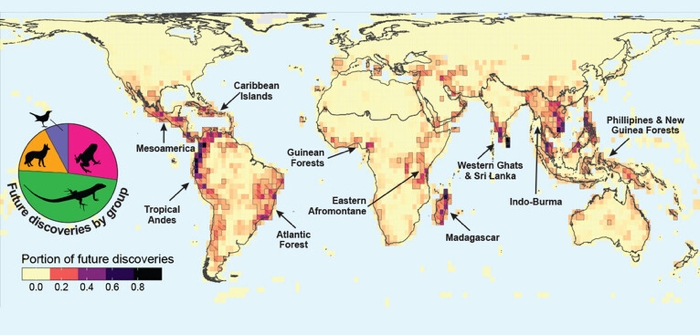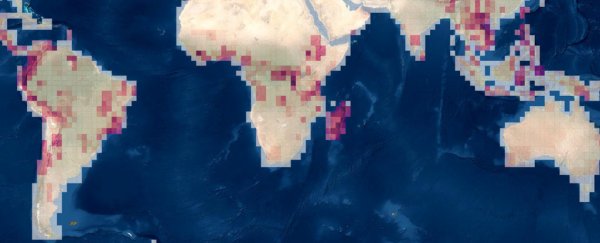Maps usually exist for the purpose of charting landscapes of the known. In times of crisis, though, maps of the unknown may be just as vital a resource.
That's the thinking behind a new scientific effort to map all the places on Earth where undiscovered species are most likely to be living today.
Against the backdrop of the world's biodiversity crisis – in which we're losing known and presumably unknown species at an alarming rate – such speculative cartography may prove our best and only chance to document, classify, and possibly save animals before they are permanently surrendered to extinction, scientists warn.
"Conservative estimates suggest only 13 to 18 percent of all living species may be known at this point, although this number could be as low as 1.5 percent," researchers from Yale University explain in a new study.
"Without inclusion in conservation decision-making and international commitments, these [undiscovered] species and their functions may be forever lost in ignorance."
 (Mario Moura and Walter Jetz)
(Mario Moura and Walter Jetz)
To address this 'biodiversity shortfall', ecologists Mario Moura and Walter Jetz created a model extrapolating where unknown species of terrestrial vertebrates might likely exist today, based on biological, environmental, and sociological factors associated with the over 32,000 terrestrial vertebrates already known to biologists.
"The chances of being discovered and described early are not equal among species," says Moura, who co-authored the study while working as a postdoctoral associate in Jetz's lab and is now a professor at the Federal University of Paraiba in Brazil.
In short, large animals with broad geographical range are unlikely to have many cousins we don't already know about. By contrast, small animals who inhabit tiny or inaccessible crevices in the landscape could account for multitudes of undiscovered vertebrates that have never been categorized on the tree of life.
"We tend to discover the 'obvious' first and the 'obscure' later," Moura says. "We need more funding for taxonomists to find the remaining undiscovered species."
According to the researchers' model – which the team acknowledges is bound to be imprecise, given the nature of the estimates – amphibians and reptiles are probably the most abundant unknown animals today amongst terrestrial vertebrates.
Brazil, Indonesia, Madagascar, and Colombia are expected to contain the most undiscovered vertebrate species, potentially representing a quarter of all future discoveries, with tropical moist broadleaf forest environments in general expected to account for about half of the unknowns.
That said, we only stand to discover any of these creatures in the future if we speed our search up – and not just for vertebrates, but for plant, marine, and invertebrate species too, which are next on the researchers' list.
Many researchers say the so-called 6th mass extinction is already upon us, and we won't be able to help these animals if they die before we ever find them.
"After centuries of efforts by biodiversity explorers and taxonomists, the catalog of life still has too many blank pages," the authors write.
"Extending the presented approach to other taxa has the potential to underpin taxonomic research initiatives that help speed up discovery before species are lost in ignorance."
The findings are reported in Nature Ecology & Evolution, and you can access an interactive version of the map of the undiscovered species here.
